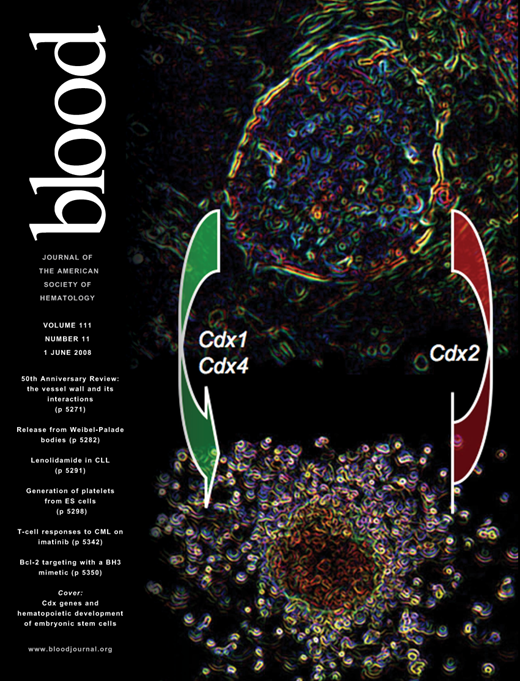To the editor:
Erdheim-Chester disease (ECD) is a non-Langerhans form of CD68+ CD1a− histiocytosis.1-4 Interferon α (IFNα) is effective in ECD.3,5 Efficacy is however depending on the site of involvement. Central nervous system (CNS) and cardiovascular involvement do not respond to IFNα and have a poor prognosis.5
Two patients suffering from Langerhans cell histiocytosis (LCH) and Rosai-Dorfman disease histiocytosis (RDD) were dramatically improved with imatinib mesylate (IM), a tyrosine kinase inhibitor, which selectively inhibits bcr-abl, KIT and platelet-derived growth factor (PDGF).6,7 IM, initially given at 100 mg/d and raised to 400 mg/d after 1 month dramatically improved LCH cerebral infiltration,6 and, for the multisystemic RDD patient,7 the manifestations almost completely resolved under 600 mg/d within 6 weeks. Rationale for the use of IM was the expression of PDGF receptor beta (PDGFr-β) on histiocytes and the inhibition of PDGF kinases by IM.8-10
PDGFr-β (Santa Cruz Biotechnology, Santa Cruz, CA) expression was studied on tissue samples from various origins of 37 ECD patients, 11 LCH patients, and 4 RDD by immunostaining on formalin-fixed, deparaffinized 4-μm tissue sections, using commercial kits, LSAB, or the EnVision+DAB system, and an automated immunostainer, according to the manufacturer's instructions (Dako North America, Carpinteria, CA). In 32 of 37 samples (86.5%)—the largest monocentric pathologic analysis of ECD—a positive PDGFr-β expression on histiocytes was observed. Three of the 11 LCH biopsies (27.3%) had histiocytes positive for PDGFr-β. None of the 4 specimens from RDD patients was positive for PDGFr-β.
Six of the 32 ECD patients positive for PDGFr-β, whose disease was severe, potentially life-threatening, multisystemic, and/or refractory to conventional therapy (including IFNα and/or autologous stem cell transplantation) were treated with IM (see Table 1). All 6 patients, followed at the Internal Medicine Department of Pitié-Salpêtrière Hospital, provided written informed consent in accordance with the Declaration of Helsinki. The medical decision to propose a treatment by IM was taken after a collegial discussion, justified by the severity of the disease in all cases and by the resistance to other treatments in 3 cases. The initial dose was 100 mg/d, increasing progressively according to tolerance and treatment efficacy. In one patient, the maximum dose reached was 800 mg/d. Five of the 6 patients received IM only. Median follow-up after IM initiation was 12.5 months (range: 6-24 months) and the maximal median daily dose was 350 mg/d. On the basis of the clinical and the radiologic outcomes, physicians (J.H. and Z.A.) judged the disease was globally “stable” in 2 and “worsening” in 4 cases. Studying the evolution of the “site by site” ECD manifestation under IM we found different response rate according to the sites of involvement. While CNS manifestations often worsened (75%), cardiovascular involvement remained stable in most of the cases (80%). IM was safe, with no major side effects observed.
The sample size of our study is large enough to draw firm conclusions on the almost unvariable presence of PDGFr-β on histiocytes of ECD. Our data, and those previously reported, suggest that the PDGFr-β expression is much more variable in LCH and RDD. Even though IM does not seem to be efficacious in ECD, we cannot rule out a partial efficacy on cardiovascular involvement. It is possible that several patients were too severe to show improvement at the time of treatment initiation, especially those with long-term lasting CNS involvement (case nos. 2, 3, and 5). In some cases doses of IM might not have been high enough (case nos. 1, 4, and 5) compared with higher doses that were given in RDD (400 to 600 mg/d).7 Tyrosine kinase inhibitors more specific of the PDGFr-β could therefore be promising drugs for the treatment of patients with severe forms of ECD resistant to IFNα therapy.
Authorship
We thank the following pathologists who provided tissue samples of patients: Dr S. Lepreux, GH Pellegrin, Bordeaux, France; Pr B. Gosselin, Centre Hospitalier Régional Universitaire de Lille, France; Dr J. Wechsler, Hôpital Henri-Mondor, Créteil, France; Pr F. Fetissof, Hôpital Trousseau, Tours, France; Pr J. Poirier and Dr M. Kujas, Hôpital Pitié-Salpêtrière, Paris, France; Dr C. Bouvier-Labit, Centre Hospitalier Universitaire Timone, Marseille; Pr J-L. Kemeny, Hôpital Gabriel Montpied, Clermont-Ferrand, France; Dr C. Lacroix, Hôpital Kremlin-Bicêtre, France; Pr A. Janin, Dr J. Brière, Hôpital Saint-Louis, Paris, France; Dr M. Polivka, Hôpital Laribosière, Paris, France; Dr W. Lepère, Kantonsspital Bruderholz, Bale, Switzeland; Pr JP. Cosyns, Cliniques Universitaires St-Luc, Brussels, Belgium.
Contribution: J.H. designed and performed the study, analyzed the clinical data and wrote the manuscript; Z.A. designed the study, analyzed the clinical data and wrote the manuscript; F.C. performed the pathology study and wrote the manuscript; N.B. performed the pathology study; C.G, J.S and B.W. referred patients and analyzed the clinical data; J-C. P. analyzed the clinical data. All authors critically reviewed the manuscript.
Conflict-of-interest disclosure: The authors declare no competing financial interests.
Correspondence: Julien Haroche, Department of Internal Medicine, Hôpital Pitié-Salpêtrière, 47-83 Boulevard de l'Hôpital, 75013 Paris, France; e-mail: julien.haroche@psl.aphp.fr.

